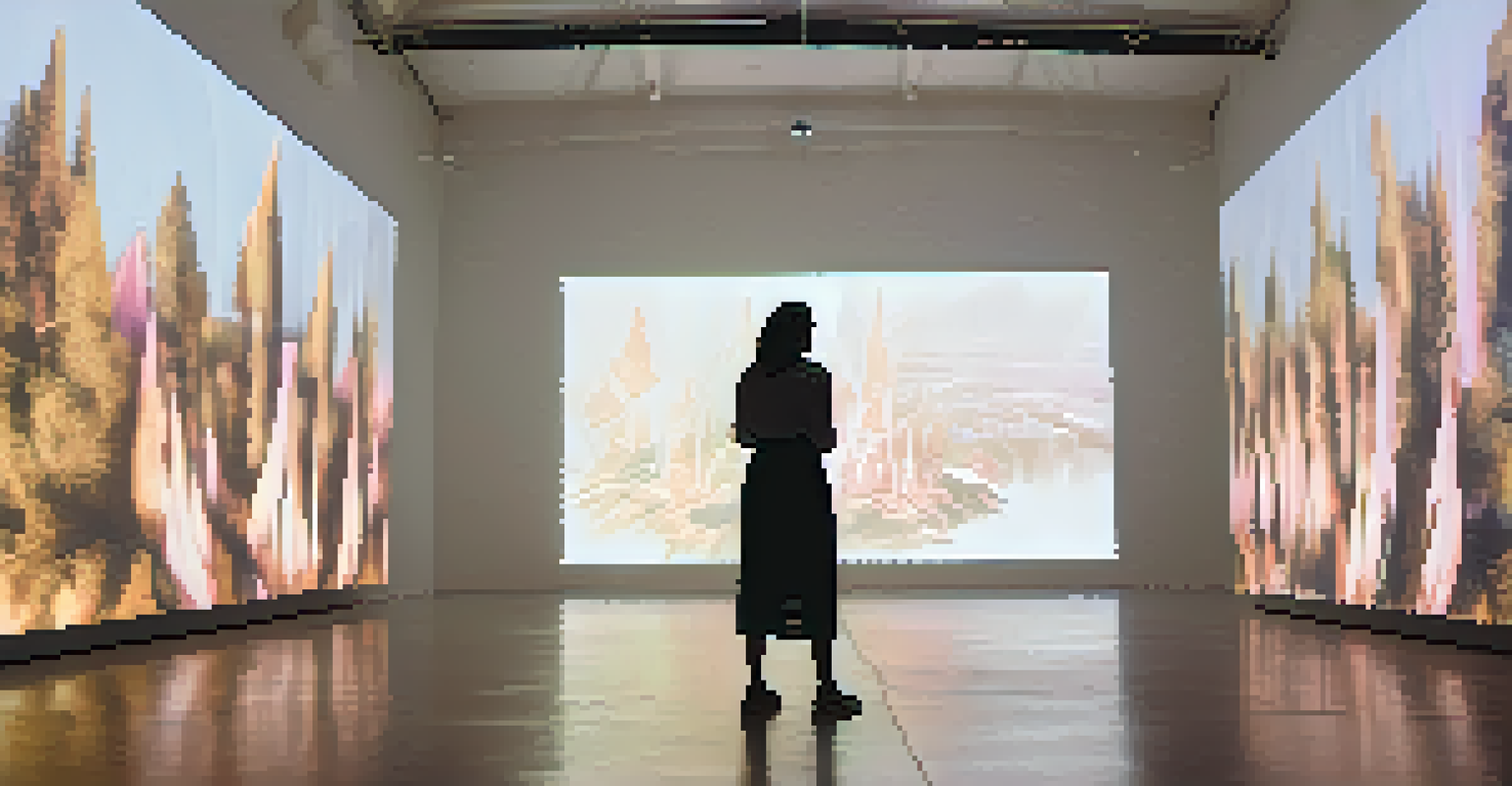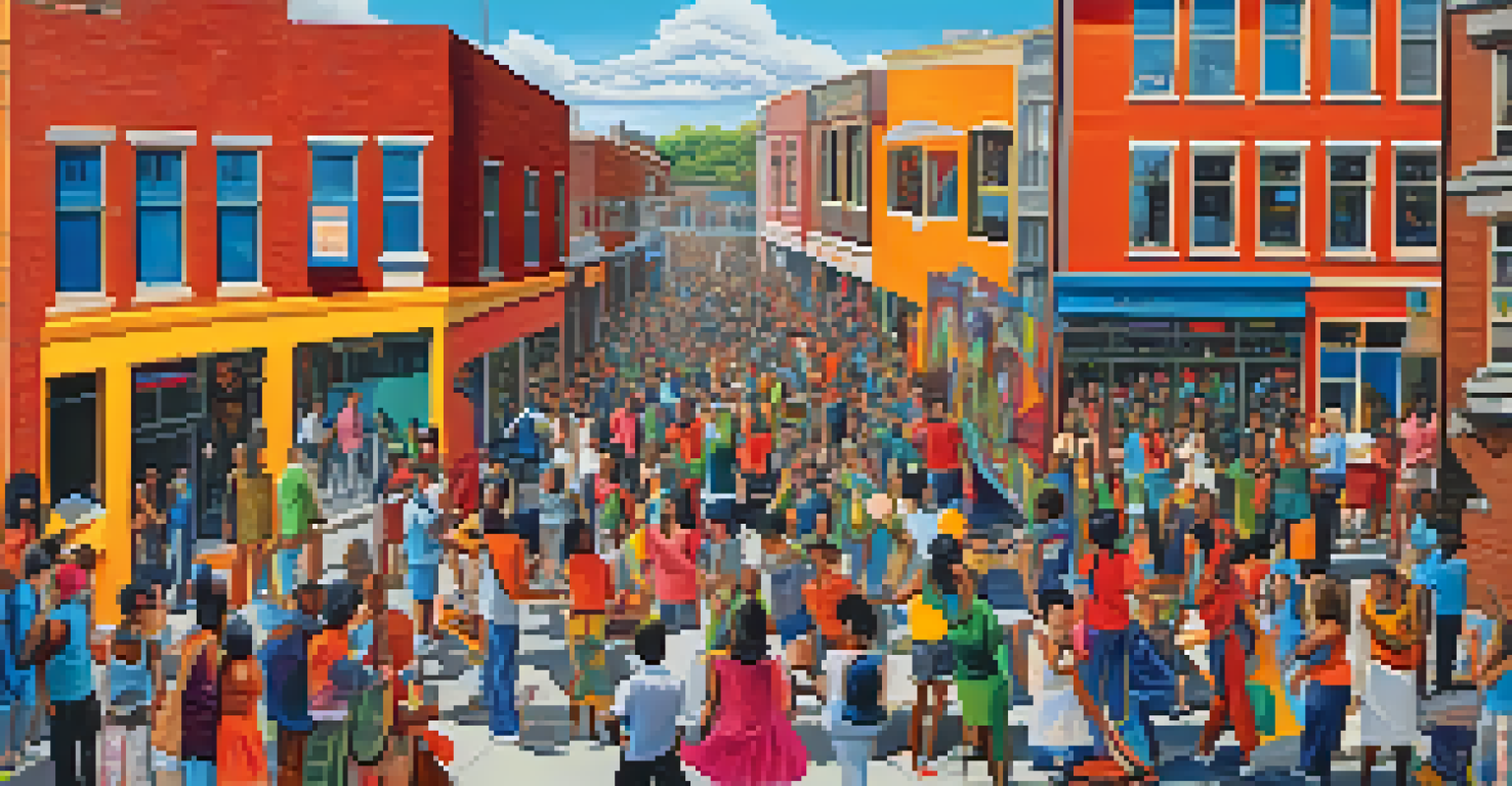Cultural Influences on Performance Art Across the Globe

Defining Performance Art and Its Cultural Roots
Performance art is an expressive medium that combines various art forms including theater, dance, and visual arts. It’s often characterized by live presentations, where the artist’s body becomes the canvas. This unique blend of disciplines is influenced heavily by cultural context, as different societies bring their own stories, traditions, and values to the stage.
Art is the most beautiful of all lies; it is the ultimate truth.
For instance, in many Indigenous cultures, performance art serves as a way to preserve history and transmit knowledge. Rituals and storytelling play a crucial role, showcasing the connection between the art and the community’s heritage. This demonstrates how performance art is not just entertainment, but a vital component of cultural identity.
As we explore performance art globally, it becomes evident that cultural roots shape the themes, styles, and purposes of the performances. This makes every piece a reflection of the artist’s environment, offering audiences a glimpse into diverse worldviews.
The Impact of Tradition on Contemporary Performance Art
Tradition plays a pivotal role in shaping contemporary performance art. Many artists draw inspiration from age-old customs, blending them with modern techniques to create unique performances. This fusion not only honors cultural heritage but also makes it accessible to a broader audience, often bridging generational gaps.

Take, for example, the way African dance has evolved. Traditional African dance moves have been incorporated into contemporary dances, creating a vibrant blend that resonates with both young and older audiences. This practice highlights the importance of cultural transmission while encouraging innovation within the art form.
Cultural Roots Shape Performance Art
Performance art is deeply influenced by cultural traditions, reflecting the unique stories and values of different societies.
Moreover, this interplay between tradition and contemporary expression often serves as a commentary on societal issues. Artists use their performances to address themes such as identity, migration, and globalization, making their cultural influences even more relevant in today’s world.
Globalization's Role in Shaping Performance Art
In our interconnected world, globalization has significantly influenced performance art. Artists from different cultural backgrounds are now collaborating, sharing ideas, and blending styles to create hybrid forms of art. This cross-cultural exchange enriches the performance art landscape, making it more diverse and dynamic.
Art is not freedom from discipline, but disciplined freedom.
For instance, the rise of digital platforms has enabled artists to showcase their work to a global audience. This visibility can lead to increased appreciation of various cultural expressions, as well as new opportunities for collaboration. Such interactions can often spark innovative ideas, resulting in performances that challenge traditional boundaries.
However, globalization also raises concerns about cultural appropriation, where elements of one culture are used without understanding or respecting their significance. This highlights the importance of cultural sensitivity and awareness in performance art, ensuring that artists honor the traditions they draw from.
Regional Variations in Performance Art Styles
Performance art varies widely across regions, reflecting the unique cultural, social, and political landscapes. In Asia, for instance, traditional forms like Kabuki in Japan and Kathakali in India showcase elaborate costumes and storytelling techniques, deeply rooted in local mythology. These performances are not only artistic expressions but also carry significant cultural meanings.
In contrast, Western performance art often leans towards experimental and avant-garde styles, emphasizing individual expression and abstract concepts. Artists like Marina Abramović have pushed the boundaries of performance art, challenging audiences to confront their perceptions and emotions in profound ways. This illustrates how regional influences can shape the form and function of performance art.
Technology Transforms Artistic Expression
The integration of technology in performance art creates immersive experiences, challenging traditional boundaries and enhancing audience engagement.
These regional variations serve to enrich the global tapestry of performance art, allowing audiences to experience a diverse array of narratives and styles. They also remind us of the importance of context in understanding the impact and significance of a performance.
The Role of Technology in Modern Performance Art
Technology has transformed performance art in remarkable ways, offering new tools for artists to explore and express their creativity. From digital projections to interactive installations, technology enhances the sensory experience, allowing audiences to engage with performances on multiple levels. This integration of tech can create immersive environments that blur the lines between the performer and the audience.
For example, virtual reality (VR) has emerged as a groundbreaking tool in performance art. Artists can transport audiences to entirely different worlds, providing a fresh perspective on narratives and themes. This not only expands the artistic possibilities but also invites viewers to participate in the storytelling process.
However, the reliance on technology also prompts discussions about authenticity and the nature of performance art. As artists navigate this new landscape, they must balance the excitement of innovation with the core values of their cultural expressions, ensuring that the essence of performance is not lost.
Cultural Exchange and Its Impact on Performance Art
Cultural exchange plays a vital role in the evolution of performance art, fostering mutual understanding and appreciation among artists from different backgrounds. When cultures intersect, they create a fertile ground for innovation, leading to performances that incorporate diverse techniques and narratives. This not only enriches the art form but also encourages dialogue about shared human experiences.
Participatory performances, which invite audience involvement, are a prime example of this exchange. Artists often draw from various cultural practices to create immersive experiences that transcend traditional boundaries. For instance, community-based performances can blend local customs with contemporary themes, resulting in a unique collaborative art form.
Cultural Exchange Fosters Innovation
Cultural exchange enriches performance art, encouraging diverse narratives and techniques that promote understanding and appreciation among artists.
These interactions often challenge stereotypes and promote cultural sensitivity, helping audiences to appreciate the beauty of diversity. As performance art continues to evolve, the importance of cultural exchange remains paramount in ensuring that it reflects the complexities of our global society.
Future Trends in Performance Art and Cultural Influence
As we look ahead, the future of performance art is poised to be shaped by ongoing cultural influences and technological advancements. Artists are increasingly exploring themes of identity, climate change, and social justice, using their platforms to raise awareness and inspire change. This trend underscores the power of performance art as a medium for activism and cultural commentary.
Additionally, the rise of social media has transformed how performances are shared and experienced. Artists can now reach wider audiences instantly, fostering global conversations about their work. This accessibility not only democratizes art but also encourages a greater diversity of voices in the performance art scene.

Ultimately, the future of performance art will likely continue to reflect the complexities of a rapidly changing world. As cultural influences evolve, artists will adapt, innovate, and challenge the status quo, ensuring that performance art remains a vital and relevant form of expression.